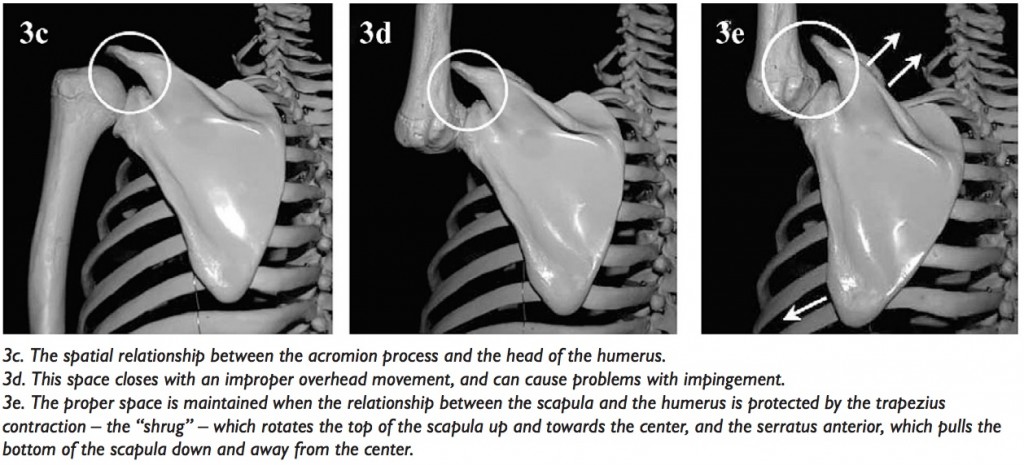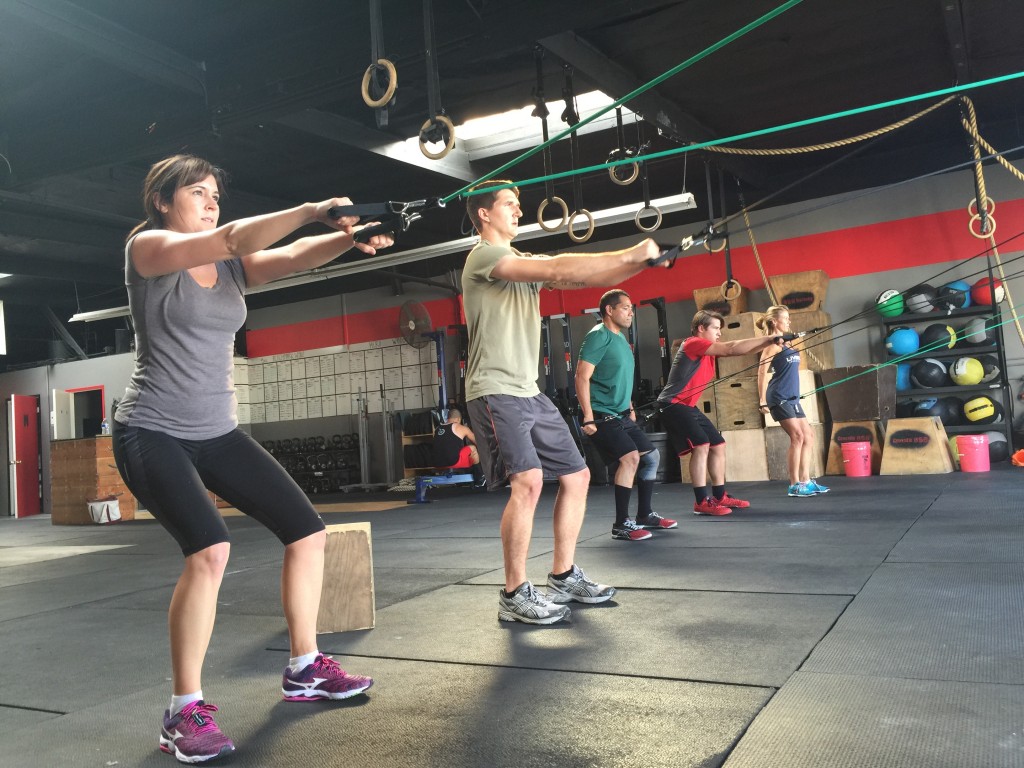“My Physical Therapist says if it weren’t for CrossFit causing so many injuries, they would be out of business.”
Over the past few years, as CrossFit has gained in popularity, I’ve heard this statement more and more. “Physical Therapist” can be interchanged with “Chiropractor” or even “Doctor”. The injuries that they are referring to are most often shoulder injuries or lower back injuries. Today, we’ll take a closer look at shoulder injuries that are seen in CrossFit and any other activity that requires repetitive shoulder movements (like golf, tennis, baseball etc). The most common shoulder injury seen is known as the “shoulder impingement”. Worst case scenario would be a rotator cuff tear.
When I hear the statement about injuries and CrossFit, the feelings instilled in me are anything but pleasant. Why? Is it because I take offense at having the finger pointed at CrossFit for various injuries? Or is it because I actually agree with the statement in certain aspects? Perhaps I’m frustrated with those CrossFit boxes that do in fact see shoulder injuries, then either don’t do anything to prevent them or just copy/paste a random article and say “read this for your shoulder issues” and call it good coaching? Or am I frustrated with those health practitioners who often have to take an oath to HELP people but instead poke fun at the CrossFit regimen, and treat the surface problem instead of try to prevent them? The answer is all of the above, and allow me to explain.
The challenge is to really look at the initial statement and ask the question: Is it really CrossFit that “causes” the injuries? Or does it have more to do with what happens outside of the gym? Are CrossFit movements to blame or are they the proverbial straw that breaks the camel’s back?
What is a shoulder impingement?
Before we go further, we should define what is a shoulder impingement and look at the anatomy of the shoulder joint. Don’t worry, we won’t get too technical and I’ll try to keep this as simple as possible. This is a great explanation from Dan John, on the anatomy of the shoulder:
“In this picture we have the shoulder joint. Here are the key structures:
- The humeral head – This is the top portion of the bone in your upper arm. Normally it should stay snugly fit centered into its socket, the glenoid fossa
- Acromion, Coracoid and Coracoacromial ligament – These structures sit above the humeral head and provide a small space aptly named the subacromial space.
- Supraspinatus Tendon (part of the rotator cuff), long head of the biceps tendon and a bursa. These structures sit between the humerus and the structures labeled above in #2 in the subacromial space. These are the structures that get impinged upon with this syndrome.”
A shoulder impingement is typically defined as when the the muscles and tendons such as the supraspinatus are pinched between the narrow gap of the head of the humerus and the acromion. Repeated pinching of the muscles and tendons in this gap causes them to become inflamed/swollen and become easier to pinch, hence the chronic nature of shoulder impingements and long healing times.
So what causes the pinching? Bad posture (more on that later). Also, repetitive overhead movements such as throwing, swinging, or even swimming, and improper overhead movements. I emphasize “improper” because it can be simply defined as the following: not shrugging the traps overhead when lifting overhead and/or not having the weight vertically aligned with your body.
Check out this picture from “On the Safety and Efficacy of Overhead Lifting” by Mark Rippetoe et al, from the CrossFit Journal, Issue 67 March 2008:
As you can see from the 3 pictures, when you shrug up and activate the traps, the space between the humerus and acromion is increased due to the rotation of the scapula. No shrug, no space. No space=more pinching=shoulder impingement. Pretty simple right?
The True Cause(s):
Sure injuries can happen in the gym. Often these are freak occurrences that are the result of a perfect storm of many variables such as the athlete’s level of: fatigue, activity, skill, attention, nutrition etc. And yes, sometimes injuries can occur from poor form (SHRUG!) due to the undertrained eye of an incompetent or inexperienced coach (which is why it’s important to find a box with GREAT, not good, coaches).
But let’s take that all off the table. Let’s assume we have great coaches and able bodied athletes. Let’s get some perspective on a workout in relation to your average day. A typical CrossFit workout lasts about an hour. Within that hour there is usually a warm up, briefing, workout, then cool down. Let’s say the workout is between 5-15 mins of that hour. Now let’s assume an overhead movement is found within those 5-15 mins of the WOD, and the overhead movements are not found every day (Good programming will incorporate rest days for your shoulders). Would performing a shoulder intensive movement for a few mins each workout, 2-3 times a week be enough to injure someone? The answer technically is yes, anything can happen even from one bad rep, or bad posture (not shrugging). However, this is sometimes the tip of the iceberg….
It’s important to look at the other 23 hours of the day, outside of the gym. What happens to your shoulders then? What position do you keep your shoulders when you sleep? What about when you are at work? Do you sit down at a desk for 8-12 hours a day? Lean over a computer and mouse? Freeze. Take a look at your shoulder position as you are reading this article! Are they hunched forward or pulled back? These are all situations where improper posture and shoulder positioning could lead to or contribute to injury.
Any time you have the shoulders hunched forward and/or have you neck craned up, and/or have your head pushed forward and/or upper back rounded, your posture is putting you more at risk for a shoulder impingement. Other factors such as your occupation may contribute to this as well: Painters, Barbers, Contractors, anyone that uses a computer for work all spend prolonged hours each day with compromised shoulder positions. Also, sleeping on one arm at night adds hours each night to holding your shoulder in a bad position.
Again, this all has a cumulative effect. Hours of bad posture each day, (check the last guy in the picture above), compounded by several days in a year, for years over a career, will add up. Lots of straws on the camel’s back, but not yet breaking it…..
How to avoid heading towards a shoulder impingement: OUTSIDE the box
First and foremost, be aware of your posture during your day to day activities especially if you sit at a desk:
- Always try to keep your shoulders pulled back to a neutral position.
- Back straight: Sit or stand up STRAIGHT!
- Chin neutral don’t jut it forward.
- Adjust your computer screen to the height where your head isn’t tilted down OR up.
- Keep your upper arms pulled back so it is vertical, and forearms are horizontal; don’t lean on your desk.
Sleep on your back if you can
- sleeping on one arm puts your shoulder in a anterior (forward) rotated position
- sleeping on your back is the best position to maintain a neutral posture
If you work in an occupation that requires you to maintain an elevated arm position (artist, hairdresser etc):
- Try to maintain all the correct posture cues as above
- Try to take occasional or frequent breaks for just a few minutes at a time to “reset” the posture
How to avoid heading towards a shoulder impingement: AT the box
- Listen for active coaching cues. A good coach will yell actionable cues if they see something that needs to be corrected: “REACH UP!” “SHRUG!” “PUSH UP ON THE BAR!” “SQUEEZE YOUR TRAPS!!” are all signs that they see inactive shoulders, or no shrug. If all your coach does, and we’ve all seen them, is yell “UP! UP! UP!” then you need to go find a new coach because all you have is a cheerleader.
- Police yourself. When going overhead or benching, ask yourself “Where are my shoulders?” More often than not, you will be able to tell if your traps are active, or if your shoulders are rounded forward. Occasionally checking in with yourself and making corrections will go far.
- Learn mobility exercises from YOUR coach. Pat Sherwood of HQ once advised me “never give your clients the ‘mobility punt'” That means don’t just tell your athletes to go to mobilitywod.com and look up exercises from Kelly Starrett. Your coach should have an arsenal of shoulder mobility movements ready to show you at any given moment’s notice.
What we doing at CrossFit 858 to help you with Shoulder Health
You may have noticed in recent weeks that we have invested in 16 stations of resistance bands for Shoulder Health exercises. The purpose of these stations is simple: keep your shoulders healthy.
Along with all the ways YOU can prevent shoulder injuries during your time in and out of the box, we are now implementing exercises that are designed to enhance your shoulder mobility and health. We will sometimes do the exercises before our workouts, sometimes after, sometimes both. There will be several days a week where we will build this into our class routines.
Physiologically, prepping the shoulders with these exercises increases blood flow to the complex joints, allowing for more supple tissues, easier movement of the joints and overall increased safety. If you have ever had rehab with a physical therapist or know someone who has, you’ll see that the exercises there and the ones we do at the stations are largely the same. However, instead of it being REhab, we are performing PREhabilitation. You can’t make a shoulder completely bulletproof and injury free, but you can lessen the chances of a nagging shoulder injury via proper education and care.
So the next time you hear someone say “XYZ says CrossFit keeps them in business” feel free to educate them and give them a broader perspective. Challenge them to find out if their PT, Chiro, or even CrossFit coach is simply addressing the problem or if they are trying to prevent it.
If you have any questions, as always, let me know.
Mark
References
1.) Fitnesspainfree.com “Shoulder Impingement: Part 1 – What It Is and Why It’s Important”
2.) Rippetoe, M., Kilgore, L., Starrett, K., (2008) On the Safety and Efficacy of Overhead Lifting The CrossFit Journal




